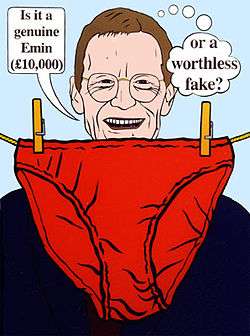Art of Europe
The art of Europe, or Western art, encompasses the history of visual art in Europe. European prehistoric art started as mobile Upper Paleolithic rock and cave painting and petroglyph art and was characteristic of the period between the Paleolithic and the Iron Age.[1] Written histories of European art often begin with the art of the Ancient Middle East and the Ancient Aegean civilizations, dating from the 3rd millennium BC. Parallel with these significant cultures, art of one form or another existed all over Europe, wherever there were people, leaving signs such as carvings, decorated artifacts and huge standing stones. However a consistent pattern of artistic development within Europe becomes clear only with the art of Ancient Greece, adopted and transformed by Rome and carried; with the Roman Empire, across much of Europe, North Africa and the Middle East.[2]
_-_Apelles_painting_Campaspe_-_2.jpg)

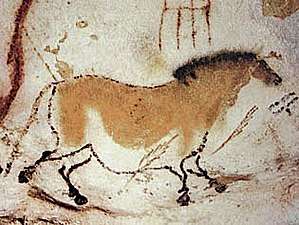 |
| History of art |
| Art history |
| European art history |
|---|
|
The influence of the art of the Classical period waxed and waned throughout the next two thousand years, seeming to slip into a distant memory in parts of the Medieval period, to re-emerge in the Renaissance, suffer a period of what some early art historians viewed as "decay" during the Baroque period,[3] to reappear in a refined form in Neo-Classicism[4] and to be reborn in Post-Modernism.[5]
Before the 1800s, the Christian church was a major influence upon European art, the commissions of the Church, architectural, painterly and sculptural, providing the major source of work for artists. The history of the Church was very much reflected in the history of art, during this period. In the same period of time there was renewed interest in heroes and heroines, tales of mythological gods and goddesses, great wars, and bizarre creatures which were not connected to religion.[6] Most art of the last 200 years has been produced without reference to religion and often with no particular ideology at all, but art has often been influenced by political issues, whether reflecting the concerns of patrons or the artist.
European art is arranged into a number of stylistic periods, which, historically, overlap each other as different styles flourished in different areas. Broadly the periods are, Classical, Byzantine, Medieval, Gothic, Renaissance, Baroque, Rococo, Neoclassical, Modern, Postmodern and New European Painting.[6]
Prehistoric art
European prehistoric art is an important part of the European cultural heritage.[7] Prehistoric art history is usually divided into four main periods: Stone Age, Neolithic, Bronze Age, and Iron Age. Most of the remaining artifacts of this period are small sculptures and cave paintings.

Much surviving prehistoric art is small portable sculptures, with a small group of female Venus figurines such as the Venus of Willendorf (24,000–22,000 BC) found across central Europe;[8] the 30 cm tall Löwenmensch figurine of about 30,000 BCE has hardly any pieces that can be related to it. The Swimming Reindeer of about 11,000 BCE is one of the finest of a number of Magdalenian carvings in bone or antler of animals in the art of the Upper Paleolithic, though they are outnumbered by engraved pieces, which are sometimes classified as sculpture.[9] With the beginning of the Mesolithic in Europe figurative sculpture greatly reduced,[10] and remained a less common element in art than relief decoration of practical objects until the Roman period, despite some works such as the Gundestrup cauldron from the European Iron Age and the Bronze Age Trundholm sun chariot.[11]
The oldest European cave art dates back 40,800, and can be found in the El Castillo Cave in Spain.[12] Other cave painting sites include Lascaux, Cave of Altamira, Grotte de Cussac, Pech Merle, Cave of Niaux, Chauvet Cave, Font-de-Gaume, Creswell Crags, Nottinghamshire, England, (Cave etchings and bas-reliefs discovered in 2003), Coliboaia cave from Romania (considered the oldest cave painting in central Europe)[13] and Magura,[1] Belogradchik, Bulgaria.[14] Rock painting was also performed on cliff faces, but fewer of those have survived because of erosion. One well-known example is the rock paintings of Astuvansalmi in the Saimaa area of Finland. When Marcelino Sanz de Sautuola first encountered the Magdalenian paintings of the Altamira cave, Cantabria, Spain in 1879, the academics of the time considered them hoaxes. Recent reappraisals and numerous additional discoveries have since demonstrated their authenticity, while at the same time stimulating interest in the artistry of Upper Palaeolithic peoples. Cave paintings, undertaken with only the most rudimentary tools, can also furnish valuable insight into the culture and beliefs of that era.
The Rock art of the Iberian Mediterranean Basin represents a very different style, with the human figure the main focus, often seen in large groups, with battles, dancing and hunting all represented, as well as other activities and details such as clothing. The figures are generally rather sketchily depicted in thin paint, with the relationships between the groups of humans and animals more carefully depicted than individual figures. Other less numerous groups of rock art, many engraved rather than painted, show similar characteristics. The Iberian examples are believed to date from a long period perhaps covering the Upper Paleolithic, Mesolithic and early Neolithic.
Prehistoric Celtic art comes from much of Iron Age Europe and survives mainly in the form of high-status metalwork skillfully decorated with complex, elegant and mostly abstract designs, often using curving and spiral forms. There are human heads and some fully represented animals, but full-length human figures at any size are so rare that their absence may represent a religious taboo. As the Romans conquered Celtic territories, it almost entirely vanishes, but the style continued in limited use in the British Isles, and with the coming of Christianity revived there in the Insular style of the Early Middle Ages.
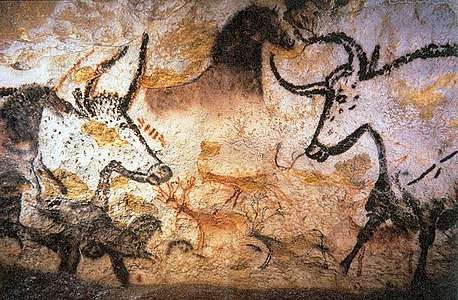 Cave paintings from Lascaux caves (Montignac, Dordogne, France)
Cave paintings from Lascaux caves (Montignac, Dordogne, France)- Bison Licking Insect Bite; 15,000–13,000 BC; antler; National Museum of Prehistory (Les Eyzies-de-Tayac-Sireuil, France)
- The Thinker; by Hamangia culture from Romania; c. 5000 BC; terracotta; height: 11.5 cm (41⁄2 in.); National Museum of Romanian History (Bucharest)
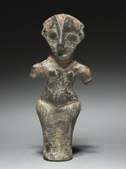 Female figure; by Vinča culture from Serbia; 4500-3500 BC; fired clay with paint; overall: 16.1 cm; Cleveland Museum of Art (Ohio, US)
Female figure; by Vinča culture from Serbia; 4500-3500 BC; fired clay with paint; overall: 16.1 cm; Cleveland Museum of Art (Ohio, US)
Ancient
Minoan
The Minoan culture is regarded as the oldest civilization in Europe.[15] The Minoan culture existed in Crete and consisted of four periods: Prepalatial, Protopalatial, Neopalatial, and the Postpalatial period between 3650 BC and 1100 BC. Not much of the art remained from the Prepalatial times, and most of artefacts still existing today are Cycladic statuettes and pottery fragments. The most prosperous period of the Cretan civilization was Neopalatial period and most of the artefacts are from this era. A large number of artefacts from the Protopalatial can be seen today in Cretan museums.
Pottery – most popular in the Protopalatial period (1900-1700 BC) – was characterized by thin walled vessels, subtle, symmetrical shapes, elegant spouts, and decorations, and dynamic lines. Dark and light values were often contrasted in Minoan pottery. The spontaneity and fluidity of the Protopalatial period later were transformed to a more stylized form of art with dissociation of naturalism in the Neopalatial period.
The palaces served as organizational, commercial, artistic, worshipping, and agricultural centres in the Cretan civilization. Cretan palaces were built without defensive walls and exhibited a central courtyard which was embraced by a number of buildings. The central courtyard served as the main meeting place of the people. The palaces had throne rooms, cult chambers, and theatres where people could gather at special events. Columns and staircases were part of the artistic expression and it is believed that they served as metaphorical elements.
The Minoan palaces are richly painted with paintings. Minoan painting was unique in that it used wet fresco techniques; it was characterized by small waists, fluidity, and vitality of the figures and was seasoned with elasticity, spontaneity, vitality, and high-contrasting colours.
Not much of the sculpture survived from the Minoan civilization. The best known example of sculptures is the Snake Goddess figurine. The sculpture depicts a goddess or a high priestess holding a snake in both hands, dressed in traditional Minoan attire, cloth covering the whole body and leaving the breasts exposed. Exquisite metal work was also a characteristic of the Minoan art. Minoan metal masters worked with imported gold and copper and mastered techniques of wax casting, embossing, gilding, nielo, and granulation.[16]
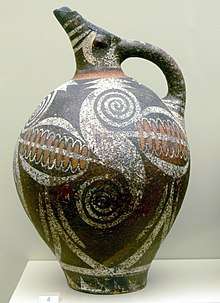 Kamares ware beaked jug; 1850-1675 BC; ceramic; height: 27 cm; from Phaistos (Crete, Greece); Heraklion Archaeological Museum (Greece)
Kamares ware beaked jug; 1850-1675 BC; ceramic; height: 27 cm; from Phaistos (Crete, Greece); Heraklion Archaeological Museum (Greece)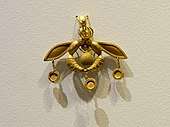
 The fresco named the Bull-Leaping Fresco; 1675-1460 BC; lime plaster; height: 0.8 m, width: 1 m; from the palace at Knossos (Crete); Heraklion Archaeological Museum
The fresco named the Bull-Leaping Fresco; 1675-1460 BC; lime plaster; height: 0.8 m, width: 1 m; from the palace at Knossos (Crete); Heraklion Archaeological Museum- Snake goddess; 1460-1410 BC (from the Minoan Neo-palatial Period); faience; height: 29.5 cm; from the Temple Repository at Knossos; Heraklion Archaeological Museum
Classical Greek and Hellenistic
Ancient Greece had great painters, great sculptors, and great architects. The Parthenon is an example of their architecture that has lasted to modern days. Greek marble sculpture is often described as the highest form of Classical art. Painting on the pottery of Ancient Greece and ceramics gives a particularly informative glimpse into the way society in Ancient Greece functioned. Black-figure vase painting and Red-figure vase painting gives many surviving examples of what Greek painting was. Some famous Greek painters on wooden panels who are mentioned in texts are Apelles, Zeuxis and Parrhasius, however no examples of Ancient Greek panel painting survive, only written descriptions by their contemporaries or by later Romans. Zeuxis lived in 5–6 BC and was said to be the first to use sfumato. According to Pliny the Elder, the realism of his paintings was such that birds tried to eat the painted grapes. Apelles is described as the greatest painter of Antiquity for perfect technique in drawing, brilliant color and modeling.
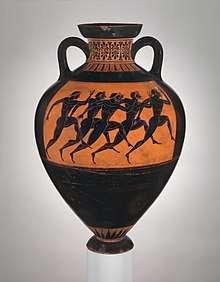 The Euphiletos Painter Panathenaic prize amphora; 530 BC; painted terracotta; height: 62.2 cm; Metropolitan Museum of Art (New York City)
The Euphiletos Painter Panathenaic prize amphora; 530 BC; painted terracotta; height: 62.2 cm; Metropolitan Museum of Art (New York City).jpg)
 Mirror with a support in the form of a draped woman; mid-5th century BC; bronze; height: 40.41 cm; Metropolitan Museum of Art
Mirror with a support in the form of a draped woman; mid-5th century BC; bronze; height: 40.41 cm; Metropolitan Museum of Art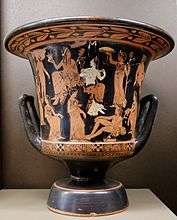
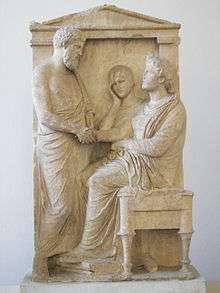 The Grave relief of Thraseas and Euandria; 375-350 BC; Pentelic marble; height: 160 cm, width: 91 cm; Pergamon Museum (Berlin)
The Grave relief of Thraseas and Euandria; 375-350 BC; Pentelic marble; height: 160 cm, width: 91 cm; Pergamon Museum (Berlin)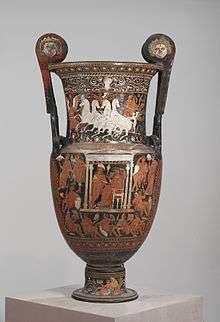 Volute krater; 320-310 BC; ceramic; height: 1.1 m; Walters Art Museum (Baltimore, US)
Volute krater; 320-310 BC; ceramic; height: 1.1 m; Walters Art Museum (Baltimore, US) Statuette of a draped woman; 2nd century BC; terracotta; height: 29.2 cm; Metropolitan Museum of Art
Statuette of a draped woman; 2nd century BC; terracotta; height: 29.2 cm; Metropolitan Museum of Art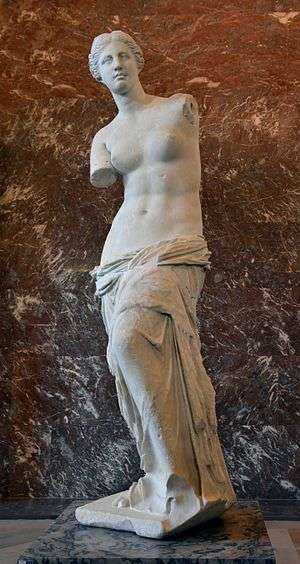

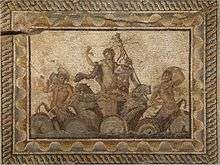 Mosaic which represents the Epiphany of Dionysus; 2nd century AD; from the Villa of Dionysus (Dion, Greece); Archeological Museum of Dion
Mosaic which represents the Epiphany of Dionysus; 2nd century AD; from the Villa of Dionysus (Dion, Greece); Archeological Museum of Dion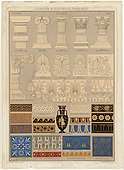 Illustrations of examples of ancient Greek ornaments and patterns, drawn in 1874
Illustrations of examples of ancient Greek ornaments and patterns, drawn in 1874
Roman
Roman art was influenced by Greece and can in part be taken as a descendant of ancient Greek painting and sculpture, but was also strongly influenced by the more local Etruscan art of Italy. Roman sculpture, is primarily portraiture derived from the upper classes of society as well as depictions of the gods. However, Roman painting does have important unique characteristics. Among surviving Roman paintings are wall paintings, many from villas in Campania, in Southern Italy, especially at Pompeii and Herculaneum. Such painting can be grouped into four main "styles" or periods[19] and may contain the first examples of trompe-l'oeil, pseudo-perspective, and pure landscape.[20]
Almost all of the surviving painted portraits from the Ancient world are a large number of coffin-portraits of bust form found in the Late Antique cemetery of Al-Fayum. They give an idea of the quality that the finest ancient work must have had. A very small number of miniatures from Late Antique illustrated books also survive, and a rather larger number of copies of them from the Early Medieval period. Early Christian art grew out of Roman popular, and later Imperial, art and adapted its iconography from these sources.
 Bronze statuette of a philosopher on a lamp stand; late 1st century BC; bronze; overall: 27.3 cm; weight: 2.9 kg; Metropolitan Museum of Art (New York City)
Bronze statuette of a philosopher on a lamp stand; late 1st century BC; bronze; overall: 27.3 cm; weight: 2.9 kg; Metropolitan Museum of Art (New York City)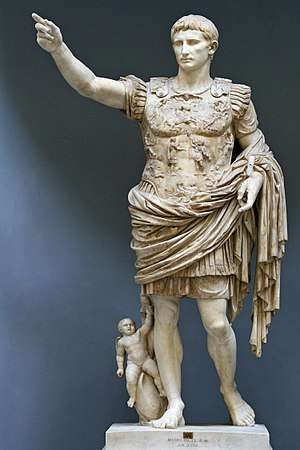
_from_the_Villa_of_P._Fannius_Synistor_at_Boscoreale_MET_DP170950.jpg) Restoration of a fresco from an Ancient villa bedroom; 50-40 BC; dimensions of the room: 265.4 x 334 x 583.9 cm; Metropolitan Museum of Art (New York City)
Restoration of a fresco from an Ancient villa bedroom; 50-40 BC; dimensions of the room: 265.4 x 334 x 583.9 cm; Metropolitan Museum of Art (New York City) Altar; circa 50 AD; marble; height: 99.5 cm, width: 61.5 cm, depth: 47 cm; Louvre
Altar; circa 50 AD; marble; height: 99.5 cm, width: 61.5 cm, depth: 47 cm; Louvre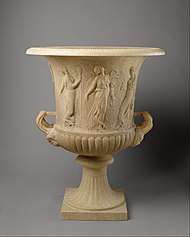 Calyx-krater with reliefs of maidens and dancing maenads; 1st century AD; Pentelic marble; height: 80.7 cm; Metropolitan Museum of Art
Calyx-krater with reliefs of maidens and dancing maenads; 1st century AD; Pentelic marble; height: 80.7 cm; Metropolitan Museum of Art Panoramic view of the Pantheon (Rome), built between 113 and 125
Panoramic view of the Pantheon (Rome), built between 113 and 125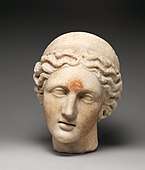 Head of a goddess wearing a diadem; 1st–2nd century; marble; height: 23 cm; Metropolitan Museum of Art
Head of a goddess wearing a diadem; 1st–2nd century; marble; height: 23 cm; Metropolitan Museum of Art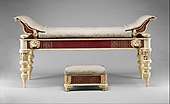 Couch and footstool; 1st–2nd century AD; wood, bone and glass; couch: 105.4 × 76.2 × 214.6 cm; Metropolitan Museum of Art
Couch and footstool; 1st–2nd century AD; wood, bone and glass; couch: 105.4 × 76.2 × 214.6 cm; Metropolitan Museum of Art- Sarcophagus with Apollo, Minerva and the Muses; circa 200 AD; from Via Appia; Antikensammlung Berlin (Berlin)
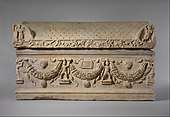 Sarcophagus with festoons; 200–225; marble; 134.6 x 223.5 cm; Metropolitan Museum of Art
Sarcophagus with festoons; 200–225; marble; 134.6 x 223.5 cm; Metropolitan Museum of Art Triumph of Neptune standing on a chariot pulled by two sea horses; mid-3rd century; Sousse Archaeological Museum (Tunisia)
Triumph of Neptune standing on a chariot pulled by two sea horses; mid-3rd century; Sousse Archaeological Museum (Tunisia) The Theseus Mosaic; 300-400 AD; marble and limestone pebbles; 4.1 x 4.2 m; Kunsthistorisches Museum (Vienna, Austria)
The Theseus Mosaic; 300-400 AD; marble and limestone pebbles; 4.1 x 4.2 m; Kunsthistorisches Museum (Vienna, Austria)
Medieval
Most surviving art from the Medieval period was religious in focus, often funded by the Church, powerful ecclesiastical individuals such as bishops, communal groups such as abbeys, or wealthy secular patrons. Many had specific liturgical functions—processional crosses and altarpieces, for example.
One of the central questions about Medieval art concerns its lack of realism. A great deal of knowledge of perspective in art and understanding of the human figure was lost with the fall of Rome. But realism was not the primary concern of Medieval artists. They were simply trying to send a religious message, a task which demands clear iconic images instead of precisely rendered ones.
Time Period: 6th century to 15th century
Early Medieval art
Migration period art is a general term for the art of the "barbarian" peoples who moved into formerly Roman territories. Celtic art in the 7th and 8th centuries saw a fusion with Germanic traditions through contact with the Anglo-Saxons creating what is called the Hiberno-Saxon style or Insular art, which was to be highly influential on the rest of the Middle Ages. Merovingian art describes the art of the Franks before about 800, when Carolingian art combined insular influences with a self-conscious classical revival, developing into Ottonian art. Anglo-Saxon art is the art of England after the Insular period. Illuminated manuscripts contain nearly all the surviving painting of the period, but architecture, metalwork and small carved work in wood or ivory were also important media.

 The helmet of Sutton Hoo; early 7th century AD; coppery alloy, iron, gold and garnet; height: 31.8 cm; British Museum
The helmet of Sutton Hoo; early 7th century AD; coppery alloy, iron, gold and garnet; height: 31.8 cm; British Museum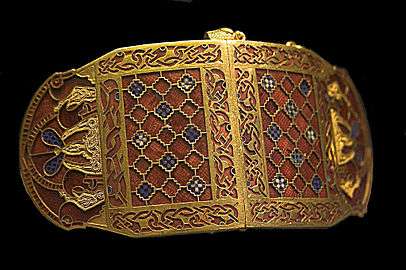 Shoulder-clasps from Sutton Hoo; early 7th century; gold, glass & garnet; length: 12.7 cm; British Museum
Shoulder-clasps from Sutton Hoo; early 7th century; gold, glass & garnet; length: 12.7 cm; British Museum The Incipit to Matthew from the Book of Lindisfarne; late 7th century; ink and pigments on vellum; 34 x 25 cm; British Library (London)
The Incipit to Matthew from the Book of Lindisfarne; late 7th century; ink and pigments on vellum; 34 x 25 cm; British Library (London)
Byzantine
Byzantine art overlaps with or merges with what we call Early Christian art until the iconoclasm period of 730-843 when the vast majority of artwork with figures was destroyed; so little remains that today any discovery sheds new understanding. After 843 until 1453 there is a clear Byzantine art tradition. It is often the finest art of the Middle Ages in terms of quality of material and workmanship, with production centered on Constantinople. Byzantine art's crowning achievement were the monumental frescos and mosaics inside domed churches, most of which have not survived due to natural disasters and the appropriation of churches to mosques.
.jpg) Slab with a relief representing the Nativity of Jesus; 4th-early 5th century; marble; Byzantine and Christian Museum (Athens)
Slab with a relief representing the Nativity of Jesus; 4th-early 5th century; marble; Byzantine and Christian Museum (Athens)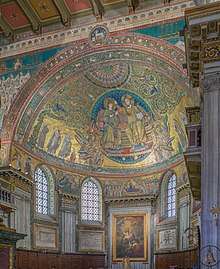 Apse of the Santa Maria Maggiore church in Rome, decorated in the 5th century with this glamorous mosaic
Apse of the Santa Maria Maggiore church in Rome, decorated in the 5th century with this glamorous mosaic Mosaics on a ceiling and some walls of the Basilica of San Vitale in Ravenna (Italy), circa 547 AD
Mosaics on a ceiling and some walls of the Basilica of San Vitale in Ravenna (Italy), circa 547 AD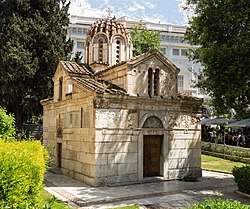 The Little Metropolis in Athens, built on unknown dates, between the 9th century to the 13th century
The Little Metropolis in Athens, built on unknown dates, between the 9th century to the 13th century- Cameo; 10th-11th centuries; jasper, almandine, emerald and chrysoprase; from Constantinopol; Moscow Kremlin Museums (Russia)
 Gospel lectionary; circa 1100; tempera, gold, and ink on parchment, and leather binding; overall: 36.8 x 29.6 x 12.4 cm, folio: 35 x 26.2 cm; Metropolitan Museum of Art (New York City)
Gospel lectionary; circa 1100; tempera, gold, and ink on parchment, and leather binding; overall: 36.8 x 29.6 x 12.4 cm, folio: 35 x 26.2 cm; Metropolitan Museum of Art (New York City) Icon of the New Testament Trinity; circa 1450; tempera and gold on wood panel (poplar); Cleveland Museum of Art (Cleveland, Ohio, US)
Icon of the New Testament Trinity; circa 1450; tempera and gold on wood panel (poplar); Cleveland Museum of Art (Cleveland, Ohio, US) Page of an Armenian illuminated manuscript; 1637–1638; tempera colors, gold paint, and gold leaf on parchment; height: 25.2 cm; Getty Center (Los Angeles)
Page of an Armenian illuminated manuscript; 1637–1638; tempera colors, gold paint, and gold leaf on parchment; height: 25.2 cm; Getty Center (Los Angeles)
Romanesque
Romanesque art refers to the period from about 1000 to the rise of Gothic art in the 12th century. This was a period of increasing prosperity, and the first to see a coherent style used across Europe, from Scandinavia to Switzerland. Romanesque art is vigorous and direct, was originally brightly coloured, and is often very sophisticated. Stained glass and enamel on metalwork became important media, and larger sculptures in the round developed, although high relief was the principal technique. Its architecture is dominated by thick walls, and round-headed windows and arches, with much carved decoration.
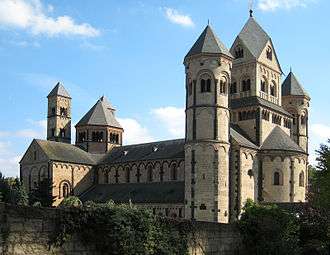 Maria Laach Abbey (near Andernach, Germany), one of the most iconic Romanesque churches
Maria Laach Abbey (near Andernach, Germany), one of the most iconic Romanesque churches.jpg)
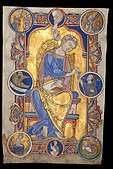 Miniature of Saint John the Evangelist; before 1147; illumination on parchment; 35.5 cm; Avesnes-sur-Helpe (France)
Miniature of Saint John the Evangelist; before 1147; illumination on parchment; 35.5 cm; Avesnes-sur-Helpe (France) The stoning of Saint Stephen; 1160s; fresco; height: 1.3 m; Saint John Abbey (Val Müstair, Canton of Grisons, Switzerland)
The stoning of Saint Stephen; 1160s; fresco; height: 1.3 m; Saint John Abbey (Val Müstair, Canton of Grisons, Switzerland)
Gothic
Gothic art is a variable term depending on the craft, place and time. The term originated with Gothic architecture in 1140, but Gothic painting did not appear until around 1200 (this date has many qualifications), when it diverged from Romanesque style. Gothic sculpture was born in France in 1144 with the renovation of the Abbey Church of S. Denis and spread throughout Europe, by the 13th century it had become the international style, replacing Romanesque. International Gothic describes Gothic art from about 1360 to 1430, after which Gothic art merges into Renaissance art at different times in different places. During this period forms such as painting, in fresco and on panel, become newly important, and the end of the period includes new media such as prints.
 Part of the Royal Portal; 1145–1155; limestone; Chartres Cathedral (Chartres, France)
Part of the Royal Portal; 1145–1155; limestone; Chartres Cathedral (Chartres, France) North transept windows; circa 1230–1235; stained glass; diameter (rose window): 10.2 m; Chartres Cathedral
North transept windows; circa 1230–1235; stained glass; diameter (rose window): 10.2 m; Chartres Cathedral Scenes from the Legend of Saint Vincent of Saragossa; 1245–1247; pot-metal glass, vitreous paint, and lead; overall: 373.4 x 110.5 cm; Metropolitan Museum of Art (New York City)
Scenes from the Legend of Saint Vincent of Saragossa; 1245–1247; pot-metal glass, vitreous paint, and lead; overall: 373.4 x 110.5 cm; Metropolitan Museum of Art (New York City) French diptych with the coronation of the Virgin and the Last Judgment; 1260–1270; elephant ivory with metal mounts; overall: 12.7 x 13 x 1.9 cm; Metropolitan Museum of Art
French diptych with the coronation of the Virgin and the Last Judgment; 1260–1270; elephant ivory with metal mounts; overall: 12.7 x 13 x 1.9 cm; Metropolitan Museum of Art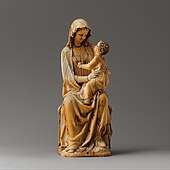 Enthroned Virgin and child; 1260-1280; elephant ivory with traces of paint and gilding; overall: 18.4 x 7.6 x 7.3 cm; Metropolitan Museum of Art
Enthroned Virgin and child; 1260-1280; elephant ivory with traces of paint and gilding; overall: 18.4 x 7.6 x 7.3 cm; Metropolitan Museum of Art Bifolium with the decretals of gratian; circa 1290; tempera and gold on parchment, brown ink, and modern leather binding; overall: 48.3 x 29.2 x 1.3 cm, opened: 47.2 cm; Metropolitan Museum of Art
Bifolium with the decretals of gratian; circa 1290; tempera and gold on parchment, brown ink, and modern leather binding; overall: 48.3 x 29.2 x 1.3 cm, opened: 47.2 cm; Metropolitan Museum of Art German diptych with religious scenes; 1300–1325; silver gilt with translucent and opaque enamels; overall (opened): 6.1 x 8.6 x 0.8 cm; Metropolitan Museum of Art
German diptych with religious scenes; 1300–1325; silver gilt with translucent and opaque enamels; overall (opened): 6.1 x 8.6 x 0.8 cm; Metropolitan Museum of Art.jpg) Page of Très Riches Heures du Duc de Berry depictic the funeral of Raymond Diocrès; 1411-1416 and 1485–1486; tempera on vellum; height: 29 cm, width: 21 cm; Condé Museum (Chantilly, France)
Page of Très Riches Heures du Duc de Berry depictic the funeral of Raymond Diocrès; 1411-1416 and 1485–1486; tempera on vellum; height: 29 cm, width: 21 cm; Condé Museum (Chantilly, France)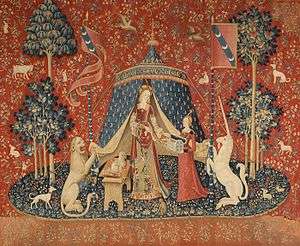 The Lady and the Unicorn, the title given to a series of six tapestries woven in Flanders, this one being called À Mon Seul Désir; late 15th century; wool and silk; 377 x 473 cm; Musée de Cluny (Paris)
The Lady and the Unicorn, the title given to a series of six tapestries woven in Flanders, this one being called À Mon Seul Désir; late 15th century; wool and silk; 377 x 473 cm; Musée de Cluny (Paris) Austrian statue of Enthroned Virgin; 1490–1500; limestone with gesso, painted and gilded; 80.3 x 59.1 x 23.5 cm; Metropolitan Museum of Art
Austrian statue of Enthroned Virgin; 1490–1500; limestone with gesso, painted and gilded; 80.3 x 59.1 x 23.5 cm; Metropolitan Museum of Art
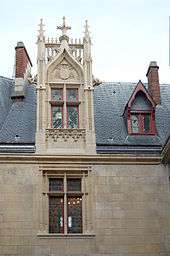 Flamboyant Gothic cross-windows of the Hôtel de Sens (Paris)
Flamboyant Gothic cross-windows of the Hôtel de Sens (Paris)
Renaissance

The Renaissance is characterized by a focus on the arts of Ancient Greece and Rome, which led to many changes in both the technical aspects of painting and sculpture, as well as to their subject matter. It began in Italy, a country rich in Roman heritage as well as material prosperity to fund artists. During the Renaissance, painters began to enhance the realism of their work by using new techniques in perspective, thus representing three dimensions more authentically. Artists also began to use new techniques in the manipulation of light and darkness, such as the tone contrast evident in many of Titian's portraits and the development of sfumato and chiaroscuro by Leonardo da Vinci. Sculptors, too, began to rediscover many ancient techniques such as contrapposto. Following with the humanist spirit of the age, art became more secular in subject matter, depicting ancient mythology in addition to Christian themes. This genre of art is often referred to as Renaissance Classicism. In the North, the most important Renaissance innovation was the widespread use of oil paints, which allowed for greater colour and intensity.
From Gothic to the Renaissance
During the late 13th century and early 14th century, much of the painting in Italy was Byzantine in character, notably that of Duccio of Siena and Cimabue of Florence, while Pietro Cavallini in Rome was more Gothic in style. During the 13th century, Italian sculptors began to draw inspiration not only from medieval prototypes, but also from ancient works.[23]
In 1290, Giotto began painting in a manner that was less traditional and more based upon observation of nature. His famous cycle at the Scrovegni Chapel, Padua, is seen as the beginnings of a Renaissance style.
Other painters of the 14th century were carried the Gothic style to great elaboration and detail. Notable among these painters are Simone Martini and Gentile da Fabriano.
In the Netherlands, the technique of painting in oils rather than tempera, led itself to a form of elaboration that was not dependent upon the application of gold leaf and embossing, but upon the minute depiction of the natural world. The art of painting textures with great realism evolved at this time. Dutch painters such as Jan van Eyck and Hugo van der Goes were to have great influence on Late Gothic and Early Renaissance painting.
Early Renaissance
The ideas of the Renaissance first emerged in the city-state of Florence, Italy. The sculptor Donatello returned to classical techniques such as contrapposto and classical subjects like the unsupported nude—his second sculpture of David was the first free-standing bronze nude created in Europe since the Roman Empire. The sculptor and architect Brunelleschi studied the architectural ideas of ancient Roman buildings for inspiration. Masaccio perfected elements like composition, individual expression, and human form to paint frescoes, especially those in the Brancacci Chapel, of surprising elegance, drama, and emotion.
A remarkable number of these major artists worked on different portions of the Florence Cathedral. Brunelleschi's dome for the cathedral was one of the first truly revolutionary architectural innovations since the Gothic flying buttress. Donatello created many of its sculptures. Giotto and Lorenzo Ghiberti also contributed to the cathedral.
.jpg)
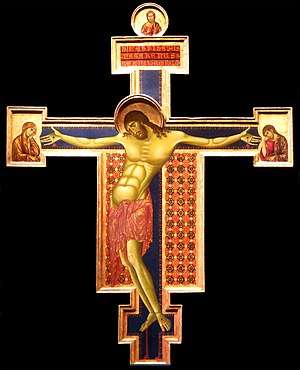
 Crucifix; Giotto; circa 1300; tempera on panel; 5.78 x 4.06 m; Santa Maria Novella (Florence, Italy)[26]
Crucifix; Giotto; circa 1300; tempera on panel; 5.78 x 4.06 m; Santa Maria Novella (Florence, Italy)[26] The Maestà Altarpiece; by Duccio; 1308-1311; tempera on panel; 2.46 x 4.67 m; Museo dell'Opera del Duomo (Siena, Italy)
The Maestà Altarpiece; by Duccio; 1308-1311; tempera on panel; 2.46 x 4.67 m; Museo dell'Opera del Duomo (Siena, Italy)
High Renaissance
High Renaissance artists include such figures as Leonardo da Vinci, Michelangelo Buonarroti, and Raffaello Sanzio.
The 15th-century artistic developments in Italy (for example, the interest in perspectival systems, in depicting anatomy, and in classical cultures) matured during the 16th century, accounting for the designations "Early Renaissance" for the 15th century and "High Renaissance" for the 16th century. Although no singular style characterizes the High Renaissance, the art of those most closely associated with this period—Leonardo da Vinci, Raphael, Michelangelo, and Titian—exhibits an astounding mastery, both technical and aesthetic. High Renaissance artists created works of such authority that generations of later artists relied on these artworks for instruction. These exemplary artistic creations further elevated the prestige of artists. Artists could claim divine inspiration, thereby raising visual art to a status formerly given only to poetry. Thus, painters, sculptors, and architects came into their own, successfully claiming for their work a high position among the fine arts. In a sense, 16th- century masters created a new profession with its own rights of expression and its own venerable character.
 The Tempietto (towards 1502-1510) in a narrow courtyard of the San Pietro in Montorio from Rome
The Tempietto (towards 1502-1510) in a narrow courtyard of the San Pietro in Montorio from Rome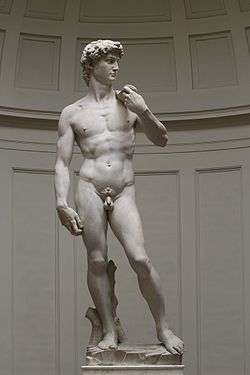
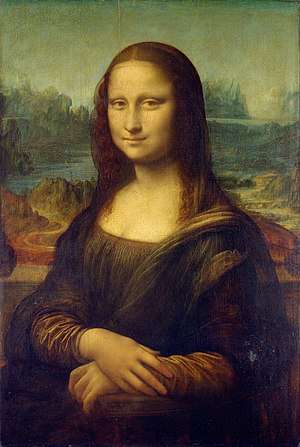 Mona Lisa; by Leonardo da Vinci; c. 1503–1506, perhaps continuing until c. 1517; oil on poplar panel; 77 cm × 53 cm; Louvre
Mona Lisa; by Leonardo da Vinci; c. 1503–1506, perhaps continuing until c. 1517; oil on poplar panel; 77 cm × 53 cm; Louvre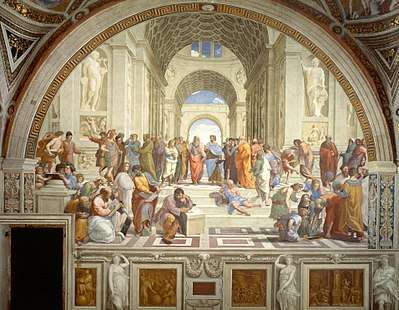
Northern art up to the Renaissance
Early Netherlandish painting developed (but did not strictly invent) the technique of oil painting to allow greater control in painting minute detail with realism—Jan van Eyck (1366–1441) was a figure in the movement from illuminated manuscripts to panel paintings.
Hieronymus Bosch (1450?–1516), a Dutch painter, is another important figure in the Northern Renaissance. In his paintings, he used religious themes, but combined them with grotesque fantasies, colorful imagery, and peasant folk legends. His paintings often reflect the confusion and anguish associated with the end of the Middle Ages.
Albrecht Dürer introduced Italian Renaissance style to Germany at the end of the 15th century, and dominated German Renaissance art.
Time Period:
- Italian Renaissance: Late 14th century to Early 16th century
- Northern Renaissance: 16th century
 The Ghent Altarpiece; by Jan and Hubert van Eyck; 1432; oil on oak wood; 3.4 m × 4.6 m (opened like in this image); St Bavo's Cathedral (Ghent, Belgium)
The Ghent Altarpiece; by Jan and Hubert van Eyck; 1432; oil on oak wood; 3.4 m × 4.6 m (opened like in this image); St Bavo's Cathedral (Ghent, Belgium)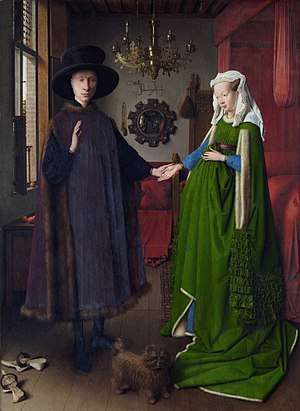 The Arnolfini Portrait; by Jan van Eyck; 1434; oil on panel; 82.2 x 60 cm; National Gallery (London)
The Arnolfini Portrait; by Jan van Eyck; 1434; oil on panel; 82.2 x 60 cm; National Gallery (London)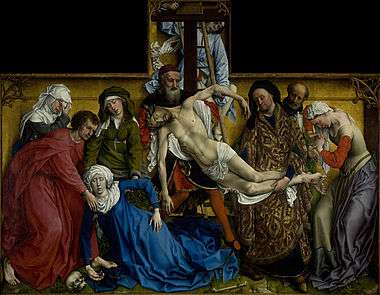 The Descent from the Cross; by Rogier van der Weyden; circa 1442; oil on oak panel; 220 × 262 cm; Museo del Prado (Madrid, Spain)
The Descent from the Cross; by Rogier van der Weyden; circa 1442; oil on oak panel; 220 × 262 cm; Museo del Prado (Madrid, Spain) The Garden of Earthly Delights; by Hieronymus Bosch; c. 1504; oil on panel; 2.2 × 1.95 m – the central panel; Museo del Prado
The Garden of Earthly Delights; by Hieronymus Bosch; c. 1504; oil on panel; 2.2 × 1.95 m – the central panel; Museo del Prado_enhanced.png) The Rhinoceros; by Albrecht Dürer; 1515; woodcut; 23.5 cm × 29.8 cm; National Gallery of Art (Washington, D.C.)
The Rhinoceros; by Albrecht Dürer; 1515; woodcut; 23.5 cm × 29.8 cm; National Gallery of Art (Washington, D.C.)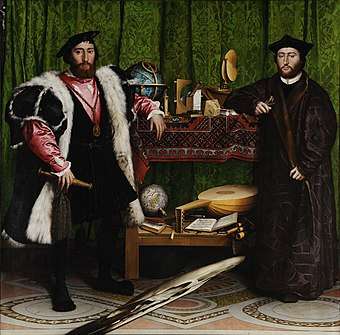 The Ambassadors; by Hans Holbein the Younger; 1533; oil on panel; 2.07 × 2.09; National Gallery (London)
The Ambassadors; by Hans Holbein the Younger; 1533; oil on panel; 2.07 × 2.09; National Gallery (London)_MET_DP256960.jpg) The Parade Armour of Henry II of France; by Étienne Delaune; circa 1555; chased steel; height: 187.96 cm, weight: 24.2 kg; Metropolitan Museum of Art (New York City)
The Parade Armour of Henry II of France; by Étienne Delaune; circa 1555; chased steel; height: 187.96 cm, weight: 24.2 kg; Metropolitan Museum of Art (New York City)_-_Google_Art_Project.jpg) The Tower of Babel; by Pieter Bruegel the Elder; 1563; oil on panel: 1.14 × 1.55 cm; Kunsthistorisches Museum (Vienna, Austria)
The Tower of Babel; by Pieter Bruegel the Elder; 1563; oil on panel: 1.14 × 1.55 cm; Kunsthistorisches Museum (Vienna, Austria)
Mannerism, Baroque, and Rococo

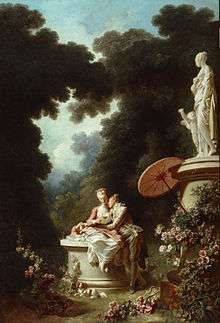
In European art, Renaissance Classicism spawned two different movements—Mannerism and the Baroque. Mannerism, a reaction against the idealist perfection of Classicism, employed distortion of light and spatial frameworks in order to emphasize the emotional content of a painting and the emotions of the painter. The work of El Greco is a particularly clear example of Mannerism in painting during the late 16th, early 17th centuries. Northern Mannerism took longer to develop, and was largely a movement of the last half of the 16th century. Baroque art took the representationalism of the Renaissance to new heights, emphasizing detail, movement, lighting, and drama in their search for beauty. Perhaps the best known Baroque painters are Caravaggio, Rembrandt, Peter Paul Rubens, and Diego Velázquez.
A rather different art developed out of northern realist traditions in 17th-century Dutch Golden Age painting, which had very little religious art, and little history painting, instead playing a crucial part in developing secular genres such as still life, genre paintings of everyday scenes, and landscape painting. While the Baroque nature of Rembrandt's art is clear, the label is less use for Vermeer and many other Dutch artists. Flemish Baroque painting shared a part in this trend, while also continuing to produce the traditional categories.
Baroque art is often seen as part of the Counter-Reformation—the artistic element of the revival of spiritual life in the Roman Catholic Church. Additionally, the emphasis that Baroque art placed on grandeur is seen as Absolutist in nature. Religious and political themes were widely explored within the Baroque artistic context, and both paintings and sculptures were characterised by a strong element of drama, emotion and theatricality. Famous Baroque artists include Caravaggio or Rubens.[27] Artemisia Gentileschi was another noteworthy artist, who was inspired by Caravaggio's style. Baroque art was particularly ornate and elaborate in nature, often using rich, warm colours with dark undertones. Pomp and grandeur were important elements of the Baroque artistic movement in general, as can be seen when Louis XIV said, "I am grandeur incarnate"; many Baroque artists served kings who tried to realize this goal. Baroque art in many ways was similar to Renaissance art; as a matter of fact, the term was initially used in a derogative manner to describe post-Renaissance art and architecture which was over-elaborate.[27] Baroque art can be seen as a more elaborate and dramatic re-adaptation of late Renaissance art.
By the 18th century, however, Baroque art was falling out of fashion as many deemed it too melodramatic and also gloomy, and it developed into the Rococo, which emerged in France. Rococo art was even more elaborate than the Baroque, but it was less serious and more playful.[28] Whilst the Baroque used rich, strong colours, Rococo used pale, creamier shades. The artistic movement no longer placed an emphasis on politics and religion, focusing instead on lighter themes such as romance, celebration, and appreciation of nature. Rococo art also contrasted the Baroque as it often refused symmetry in favor of asymmetrical designs. Furthermore, it sought inspiration from the artistic forms and ornamentation of Far Eastern Asia, resulting in the rise in favour of porcelain figurines and chinoiserie in general.[29] The 18th-century style flourished for a short while; nevertheless, the Rococo style soon fell out of favor, being seen by many as a gaudy and superficial movement emphasizing aesthetics over meaning. Neoclassicism in many ways developed as a counter movement of the Rococo, the impetus being a sense of disgust directed towards the latter's florid qualities.
Mannerism (16th century)
 Entombment; by Jacopo da Pontormo; 1525-1528; oil on panel; 3.12 x 1.9 m; Santa Felicita (Florence, Italy)
Entombment; by Jacopo da Pontormo; 1525-1528; oil on panel; 3.12 x 1.9 m; Santa Felicita (Florence, Italy)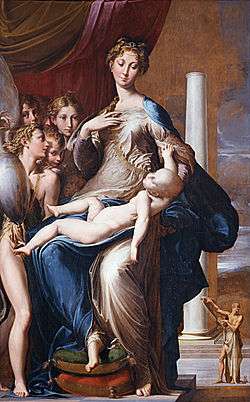 Madonna with the Long Neck; by Parmigianino; 1534-1540; oil on panel; 2.19 x 1.32 m; Uffizi Gallery (Florence)
Madonna with the Long Neck; by Parmigianino; 1534-1540; oil on panel; 2.19 x 1.32 m; Uffizi Gallery (Florence)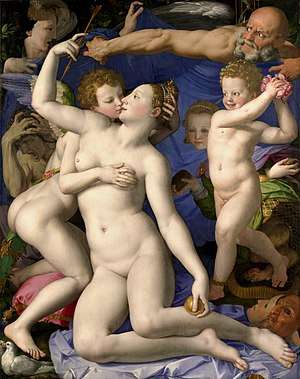 Venus, Cupid, Folly and Time; by Bronzino; mid-1540s; oil on panel; 1.46 x 1.16 m; National Gallery (London)
Venus, Cupid, Folly and Time; by Bronzino; mid-1540s; oil on panel; 1.46 x 1.16 m; National Gallery (London) Summer; by Giuseppe Arcimboldo; 1563; oil on panel; 67 x 50.8 cm; Kunsthistorisches Museum (Vienna, Austria)
Summer; by Giuseppe Arcimboldo; 1563; oil on panel; 67 x 50.8 cm; Kunsthistorisches Museum (Vienna, Austria)
Baroque (early 17th century to mid-early 18th century)
 The Four Continents; by Peter Paul Rubens; circa 1615; oil on canvas; 209 x 284 cm; Kunsthistorisches Museum (Vienna, Austria)
The Four Continents; by Peter Paul Rubens; circa 1615; oil on canvas; 209 x 284 cm; Kunsthistorisches Museum (Vienna, Austria)%2C_1625-50_ca.jpg) Dutch wardrobe; 1625-1650; oak with ebony and rosewood veneers; overall: 244.5 x 224.3 x 85.2 cm; Cleveland Museum of Art (Cleveland, Ohio, US)
Dutch wardrobe; 1625-1650; oak with ebony and rosewood veneers; overall: 244.5 x 224.3 x 85.2 cm; Cleveland Museum of Art (Cleveland, Ohio, US) The Night Watch; by Rembrandt; 1642; oil on canvas; 363 × 437 cm; Rijksmuseum (Amsterdam, the Netherlands)
The Night Watch; by Rembrandt; 1642; oil on canvas; 363 × 437 cm; Rijksmuseum (Amsterdam, the Netherlands) The Ecstasy of Saint Teresa; by Gian Lorenzo Bernini; 1647–1652; marble; height: 3.5 m; Santa Maria della Vittoria (Rome)
The Ecstasy of Saint Teresa; by Gian Lorenzo Bernini; 1647–1652; marble; height: 3.5 m; Santa Maria della Vittoria (Rome)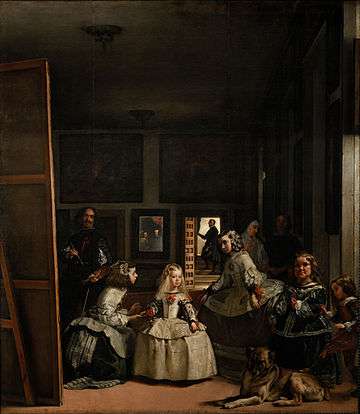 Las Meninas; by Diego Velázquez; 1656–1657; oil on canvas; 318 cm × 276 cm; Museo del Prado (Madrid, Spain)
Las Meninas; by Diego Velázquez; 1656–1657; oil on canvas; 318 cm × 276 cm; Museo del Prado (Madrid, Spain)
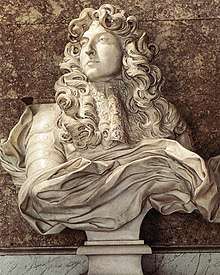 The 'Bust of Louis XIV; by Gian Lorenzo Bernini; 1665; marble; 105 × 99 × 46 cm; Palace of Versailles
The 'Bust of Louis XIV; by Gian Lorenzo Bernini; 1665; marble; 105 × 99 × 46 cm; Palace of Versailles The Art of Painting; by Johannes Vermeer; 1666-1668; oil on canvas; 1.3 x 1.1 m; Kunsthistorisches Museum
The Art of Painting; by Johannes Vermeer; 1666-1668; oil on canvas; 1.3 x 1.1 m; Kunsthistorisches Museum Carpet with fame and fortitude; 1668-1685; knotted and cut wool pile, woven with about 90 knots per square inch; 909.3 x 459.7 cm; Metropolitan Museum of Art
Carpet with fame and fortitude; 1668-1685; knotted and cut wool pile, woven with about 90 knots per square inch; 909.3 x 459.7 cm; Metropolitan Museum of Art.jpg) Dome of the Church of the Gesù (Rome), made in 1674 by Giovanni Battista Gaulli
Dome of the Church of the Gesù (Rome), made in 1674 by Giovanni Battista Gaulli
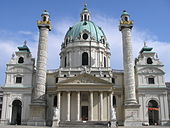 The Karlskirche in Vienna (Austria), built between 1716 and 1737
The Karlskirche in Vienna (Austria), built between 1716 and 1737
Rococo (early to mid-18th century)
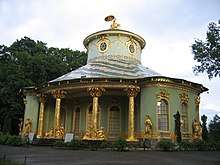
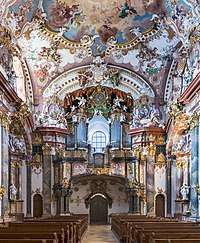 The amazing interior of the Wilhering Abbey (Wilhering, Austria). This interior has a trompe-l'œil on its ceiling, surrounded of highly decorated stuccos
The amazing interior of the Wilhering Abbey (Wilhering, Austria). This interior has a trompe-l'œil on its ceiling, surrounded of highly decorated stuccos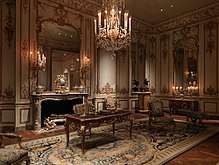 Boiserie from the Hôtel de Varengeville; circa 1736-1752; various materials, including carved, painted, and gilded oak; height: 5.58 m, width: 7.07 m, length: 12.36 m; in the Metropolitan Museum of Art (New York City)
Boiserie from the Hôtel de Varengeville; circa 1736-1752; various materials, including carved, painted, and gilded oak; height: 5.58 m, width: 7.07 m, length: 12.36 m; in the Metropolitan Museum of Art (New York City)_Oeuvre_de_Juste_Aurele_Meissonnier_(serietitel)%2C_RP-P-1998-242.jpg) Title print; by Juste Meissonnier; 1738-1749; etching on paper; 51.6 x 34.9 cm; Rijksmuseum
Title print; by Juste Meissonnier; 1738-1749; etching on paper; 51.6 x 34.9 cm; Rijksmuseum_MET_DP-12374-040.jpg) Pair of candelabrums; 18th century; soft-paste porcelain; heights (the left one): 26.8 cm, (the right one): 26.4 cm; by the Chelsea porcelain factory; Metropolitan Museum of Art
Pair of candelabrums; 18th century; soft-paste porcelain; heights (the left one): 26.8 cm, (the right one): 26.4 cm; by the Chelsea porcelain factory; Metropolitan Museum of Art Mr and Mrs Andrews; by Thomas Gainsborough; circa 1750; oil on canvas; 69.8 x 119.4 cm; National Gallery (London)
Mr and Mrs Andrews; by Thomas Gainsborough; circa 1750; oil on canvas; 69.8 x 119.4 cm; National Gallery (London)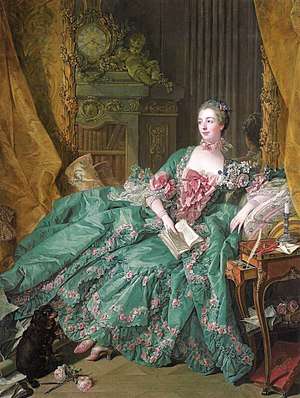 Madame de Pompadour; by François Boucher; 1756; oil on canvas; 2.01 x 1.57 m; Alte Pinakothek (Munich, Germany)
Madame de Pompadour; by François Boucher; 1756; oil on canvas; 2.01 x 1.57 m; Alte Pinakothek (Munich, Germany)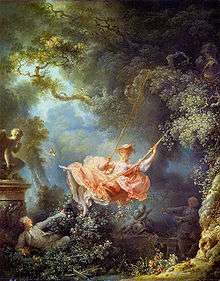 The Swing; by Jean-Honoré Fragonard; 1767–1768; oil on canvas; height: 81 cm, width: 64 cm; Wallace Collection (London)
The Swing; by Jean-Honoré Fragonard; 1767–1768; oil on canvas; height: 81 cm, width: 64 cm; Wallace Collection (London)
Neoclassicism, Romanticism, Academism and Realism
Throughout the 18th century, a counter movement opposing the Rococo sprang up in different parts of Europe, commonly known as Neoclassicism. It despised the perceived superficiality and frivolity of Rococo art, and desired for a return to the simplicity, order and 'purism' of classical antiquity, especially ancient Greece and Rome. The movement was in part also influenced by the Renaissance, which itself was strongly influenced by classical art. Neoclassicism was the artistic component of the intellectual movement known as the Enlightenment; the Enlightenment was idealistic, and put its emphasis on objectivity, reason and empirical truth. Neoclassicism had become widespread in Europe throughout the 18th century, especially in the United Kingdom, which saw great works of Neoclassical architecture spring up during this period; Neoclassicism's fascination with classical antiquity can be seen in the popularity of the Grand Tour during this decade, where wealthy aristocrats travelled to the ancient ruins of Italy and Greece. Nevertheless, a defining moment for Neoclassicism came during the French Revolution in the late 18th century; in France, Rococo art was replaced with the preferred Neoclassical art, which was seen as more serious than the former movement. In many ways, Neoclassicism can be seen as a political movement as well as an artistic and cultural one.[30] Neoclassical art places an emphasis on order, symmetry and classical simplicity; common themes in Neoclassical art include courage and war, as were commonly explored in ancient Greek and Roman art. Ingres, Canova, and Jacques-Louis David are among the best-known neoclassicists.[31]
Just as Mannerism rejected Classicism, so did Romanticism reject the ideas of the Enlightenment and the aesthetic of the Neoclassicists. Romanticism rejected the highly objective and ordered nature of Neoclassicism, and opted for a more individual and emotional approach to the arts.[32] Romanticism placed an emphasis on nature, especially when aiming to portray the power and beauty of the natural world, and emotions, and sought a highly personal approach to art. Romantic art was about individual feelings, not common themes, such as in Neoclassicism; in such a way, Romantic art often used colours in order to express feelings and emotion.[32] Similarly to Neoclassicism, Romantic art took much of its inspiration from ancient Greek and Roman art and mythology, yet, unlike Neoclassical, this inspiration was primarily used as a way to create symbolism and imagery. Romantic art also takes much of its aesthetic qualities from medievalism and Gothicism, as well as mythology and folklore. Among the greatest Romantic artists were Eugène Delacroix, Francisco Goya, J.M.W. Turner, John Constable, Caspar David Friedrich, Thomas Cole, and William Blake.[31]
Most artists attempted to take a centrist approach which adopted different features of Neoclassicist and Romanticist styles, in order to synthesize them. The different attempts took place within the French Academy, and collectively are called Academic art. Adolphe William Bouguereau is considered a chief example of this stream of art.
In the early 19th century the face of Europe, however, became radically altered by industrialization. Poverty, squalor, and desperation were to be the fate of the new working class created by the "revolution". In response to these changes going on in society, the movement of Realism emerged. Realism sought to accurately portray the conditions and hardships of the poor in the hopes of changing society. In contrast with Romanticism, which was essentially optimistic about mankind, Realism offered a stark vision of poverty and despair. Similarly, while Romanticism glorified nature, Realism portrayed life in the depths of an urban wasteland. Like Romanticism, Realism was a literary as well as an artistic movement. The great Realist painters include Jean-Baptiste-Siméon Chardin, Gustave Courbet, Jean-François Millet, Camille Corot, Honoré Daumier, Édouard Manet, Edgar Degas (both considered as Impressionists), and Thomas Eakins, among others.
The response of architecture to industrialisation, in stark contrast to the other arts, was to veer towards historicism. Although the railway stations built during this period are often considered the truest reflections of its spirit – they are sometimes called "the cathedrals of the age" – the main movements in architecture during the Industrial Age were revivals of styles from the distant past, such as the Gothic Revival. Related movements were the Pre-Raphaelite Brotherhood, who attempted to return art to its state of "purity" prior to Raphael, and the Arts and Crafts Movement, which reacted against the impersonality of mass-produced goods and advocated a return to medieval craftsmanship.
Time Period:
- Neoclassicism: mid-early 18th century to early 19th century
- Romanticism: late 18th century to mid-19th century
- Realism: 19th century
Modern art


Out of the naturalist ethic of Realism grew a major artistic movement, Impressionism. The Impressionists pioneered the use of light in painting as they attempted to capture light as seen from the human eye. Edgar Degas, Édouard Manet, Claude Monet, Camille Pissarro, and Pierre-Auguste Renoir, were all involved in the Impressionist movement. As a direct outgrowth of Impressionism came the development of Post-Impressionism. Paul Cézanne, Vincent van Gogh, Paul Gauguin, Georges Seurat are the best known Post-Impressionists.
Following the Impressionists and the Post-Impressionists came Fauvism, often considered the first "modern" genre of art. Just as the Impressionists revolutionized light, so did the fauvists rethink color, painting their canvases in bright, wild hues. After the Fauvists, modern art began to develop in all its forms, ranging from Expressionism, concerned with evoking emotion through objective works of art, to Cubism, the art of transposing a four-dimensional reality onto a flat canvas, to Abstract art. These new art forms pushed the limits of traditional notions of "art" and corresponded to the similar rapid changes that were taking place in human society, technology, and thought.
Surrealism is often classified as a form of Modern Art. However, the Surrealists themselves have objected to the study of surrealism as an era in art history, claiming that it oversimplifies the complexity of the movement (which they say is not an artistic movement), misrepresents the relationship of surrealism to aesthetics, and falsely characterizes ongoing surrealism as a finished, historically encapsulated era. Other forms of Modern art (some of which border on Contemporary art) include:
- Abstract expressionism
- Art Deco
- Art Nouveau
- Bauhaus
- Color Field painting
- Conceptual Art
- Constructivism
- Cubism
- Dada
- Der Blaue Reiter
- De Stijl
- Die Brücke
- Body Art
- Expressionism
- Fauvism
- Fluxus
- Futurism
- Happening
- Surrealism
- Lettrisme
- Lyrical Abstraction
- Land Art
- Minimalism
- Naive art
- Op art
- Performance art
- Photorealism
- Pop art
- Suprematism
- Video art
- Vorticism
Time Period:
- Impressionism: late 19th Century
- Others: First half of the 20th century
Contemporary art and Postmodern art
Modern art foreshadowed several characteristics of what would later be defined as postmodern art; as a matter of fact, several modern art movements can often be classified as both modern and postmodern, such as pop art. Postmodern art, for instance, places a strong emphasis on irony, parody and humour in general; modern art started to develop a more ironic approach to art which would later advance in a postmodern context. Postmodern art sees the blurring between the high and fine arts with low-end and commercial art; modern art started to experiment with this blurring.[32] Recent developments in art have been characterised by a significant expansion of what can now deemed to be art, in terms of materials, media, activity and concept. Conceptual art in particular has had a wide influence. This started literally as the replacement of concept for a made object, one of the intentions of which was to refute the commodification of art. However, it now usually refers to an artwork where there is an object, but the main claim for the work is made for the thought process that has informed it. The aspect of commercialism has returned to the work.
There has also been an increase in art referring to previous movements and artists, and gaining validity from that reference.
Postmodernism in art, which has grown since the 1960s, differs from Modernism in as much as Modern art movements were primarily focused on their own activities and values, while Postmodernism uses the whole range of previous movements as a reference point. This has by definition generated a relativistic outlook, accompanied by irony and a certain disbelief in values, as each can be seen to be replaced by another. Another result of this has been the growth of commercialism and celebrity. Postmodern art has questioned common rules and guidelines of what is regarded as 'fine art', merging low art with the fine arts until none is fully distinguishable.[33][34] Before the advent of postmodernism, the fine arts were characterised by a form of aesthetic quality, elegance, craftsmanship, finesse and intellectual stimulation which was intended to appeal to the upper or educated classes; this distinguished high art from low art, which, in turn, was seen as tacky, kitsch, easily made and lacking in much or any intellectual stimulation, art which was intended to appeal to the masses. Postmodern art blurred these distinctions, bringing a strong element of kitsch, commercialism and campness into contemporary fine art;[32] what is nowadays seen as fine art may have been seen as low art before postmodernism revolutionised the concept of what high or fine art truly is.[32] In addition, the postmodern nature of contemporary art leaves a lot of space for individualism within the art scene; for instance, postmodern art often takes inspiration from past artistic movements, such as Gothic or Baroque art, and both juxtaposes and recycles styles from these past periods in a different context.[32]
Some surrealists in particular Joan Miró, who called for the "murder of painting" (In numerous interviews dating from the 1930s onwards, Miró expressed contempt for conventional painting methods and his desire to "kill", "murder", or "rape" them in favor of more contemporary means of expression).[35] have denounced or attempted to "supersede" painting, and there have also been other anti-painting trends among artistic movements, such as that of Dada and conceptual art. The trend away from painting in the late 20th century has been countered by various movements, for example the continuation of Minimal Art, Lyrical Abstraction, Pop Art, Op Art, New Realism, Photorealism, Neo Geo, Neo-expressionism, New European Painting, Stuckism and various other important and influential painterly directions.
See also
- History of art
- History of painting
- Lives of the Most Excellent Painters, Sculptors, and Architects (16th century book)
- Modernism
- Painting in the Americas before European colonization
- Western European paintings in Ukrainian museums
- List of time periods
References
- Oosterbeek, Luíz. "European Prehistoric Art". Europeart. Retrieved 4 December 2012.
- Boardman, John ed., The Oxford History of Classical Art, pp. 349-369, Oxford University Press, 1993, ISBN 0198143869
- Banister Fletcher excluded nearly all Baroque buildings from his mammoth tome A History of Architecture on the Comparative Method. The publishers eventually rectified this.
- Murray, P. and Murray, L. (1963) The Art of the Renaissance. London: Thames & Hudson (World of Art), p. 9. ISBN 978-0-500-20008-7. "...in 1855 we find, for the first time, the word 'Renaissance' used — by the French historian Michelet — as an adjective to describe a whole period of history and not confined to the rebirth of Latin letters or a classically inspired style in the arts."
- Hause, S. & Maltby, W. (2001). A History of European Society. Essentials of Western Civilization (Vol. 2, pp. 245–246). Belmont, CA: Thomson Learning, Inc.
- "Art of Europe". Saint Louis Art Museum. Slam. Retrieved 4 December 2012.
- Oosterbeek, Luíz. "European Prehistoric Art". Europeart. Retrieved 4 December 2012.
- Sandars, 8-16, 29-31
- Hahn, Joachim, "Prehistoric Europe, §II: Palaeolithic 3. Portable art" in Oxford Art Online, accessed 24 August 2012; Sandars, 37-40
- Sandars, 75-80
- Sandars, 253-257, 183-185
- Kwong, Matt. "Oldest cave-man art in Europe dates back 40,800 years". CBC News. Retrieved 4 December 2012.
- "Romanian Cave May Boast Central Europe's Oldest Cave Art | Science/AAAS | News". News.sciencemag.org. 21 June 2010. Retrieved 25 August 2013.
- Gunther, Michael. "Art of Prehistoric Europe". Retrieved 4 December 2012.
- Chaniotis, Angelos. "Ancient Crete". Oxford Bibliographies. Oxford University Press. Retrieved 2 January 2013.
- "Minoan art". Greek art. Ancient-Greece.org. Retrieved 2 January 2013.
- Smith, David Michael (2017). Ancient Greece Pocket Museum. Thames and Hudson. p. 79. ISBN 978-0-500-51958-5.
- Mattinson, Lindsay (2019). Understanding Architecture A Guide To Architectural Styles. Amber Books. p. 21. ISBN 978-1-78274-748-2.
- "Roman Painting". Art-and-archaeology.com. Retrieved 25 August 2013.
- "Roman Painting". Heilbrunn Timeline of Art History. The Metropolitan Museum of Art. Retrieved 19 October 2013.
- "The Vitruvian Man". leonardodavinci.stanford.edu. Retrieved 25 March 2018.
- "BBC - Science & Nature - Leonardo - Vitruvian man". www.bbc.co.uk. Retrieved 25 March 2018.
- Fortenberry, Diane (2017). THE ART MUSEUM. Phaidon. p. 156. ISBN 978 0 7148 7502 6.
- Fortenberry, Diane (2017). THE ART MUSEUM. Phaidon. p. 156. ISBN 978 0 7148 7502 6.
- Fortenberry, Diane (2017). THE ART MUSEUM. Phaidon. p. 157. ISBN 978 0 7148 7502 6.
- Fortenberry, Diane (2017). THE ART MUSEUM. Phaidon. p. 157. ISBN 978 0 7148 7502 6.
- "Baroque Art". Arthistory-famousartists-paintings.com. 24 July 2013. Retrieved 25 August 2013.
- "Ancien Regime Rococo". Bc.edu. Archived from the original on 11 April 2018. Retrieved 25 August 2013.
- "chinoiserie facts, information, pictures - Encyclopedia.com articles about chinoiserie". www.encyclopedia.com. Retrieved 25 March 2018.
- "Art in Neoclassicism". Artsz.org. 26 February 2008. Retrieved 25 August 2013.
- James J. Sheehan, "Art and Its Publics, c. 1800," United and Diversity in European Culture c. 1800, ed. Tim Blanning and Hagen Schulze (New York: Oxford University Press, 2006), 5-18.
- "General Introduction to Postmodernism". Cla.purdue.edu. Retrieved 25 August 2013.
- Ideas About Art, Desmond, Kathleen K. John Wiley & Sons, 2011, p.148
- International postmodernism: theory and literary practice, Bertens, Hans , Routledge, 1997, p.236
- M. Rowell, Joan Mirό: Selected Writings and Interviews (London: Thames & Hudson, 1987) pp. 114–116.
Bibliography
- Sandars, Nancy K., Prehistoric Art in Europe, Penguin (Pelican, now Yale, History of Art), 1968 (nb 1st edn.; early datings now superseded)
External links
| Wikimedia Commons has media related to Art of Europe. |

